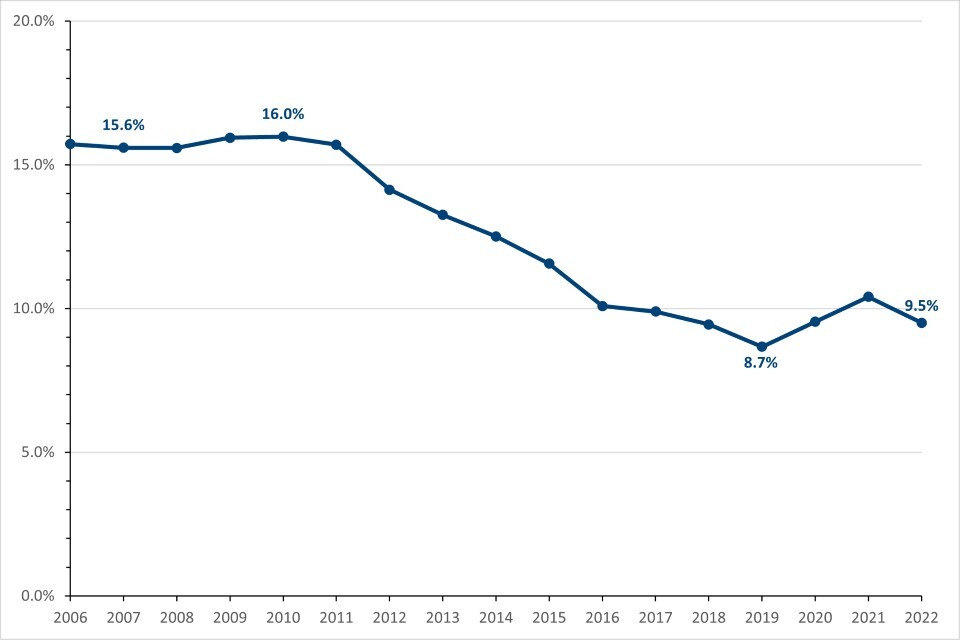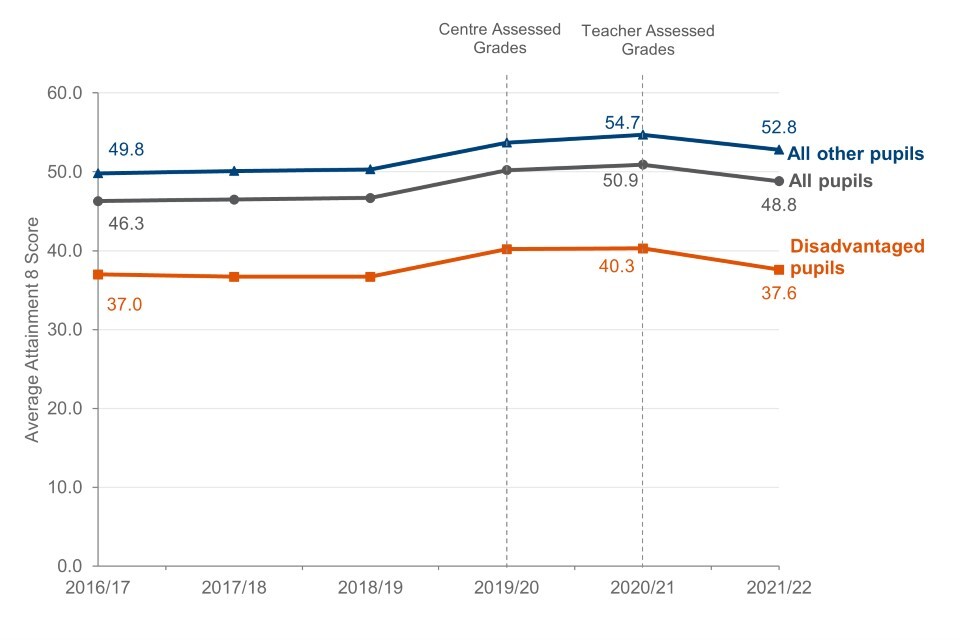Workless households and educational attainment statutory indicators 2023
Published 23 March 2023
Applies to England
Presented to the Parliament pursuant to Section A1A of the Life Chances Act 2010 as amended.
Any enquiries regarding this publication should be sent to us at helpingworklessfamilies@dwp.gov.uk
ISBN 978-1-5286-3993-4
E02884180 03/23
The Welfare Reform and Work Act 2016 amended the Child Poverty Act 2010 and placed a statutory duty on the Secretary of State to publish and lay before Parliament a report containing data on:
- children living in workless households in England
- children living in long-term workless households in England
- the educational attainment of children in England at the end of Key Stage 4
- the educational attainment of disadvantaged children in England at the end of Key Stage 4
The data contained in the report, and the provision about how the terms used in it are to be interpreted, must, so far as practical, be derived from any relevant official statistics.
Find further details in the Child Poverty Act 2010.
Definition of key terms
The Child Poverty Act 2010, as amended by the Welfare Reform and Work Act 2016, specifies that the statutory report must set out how the Secretary of State has interpreted the following terms:
1. Child:
a. for the workless households measures: people aged 0 to 15 years (that is, those who have not yet reached their 16th birthday). [footnote 1]
b. for the educational attainment measures: pupils in state-funded schools at the end of Key Stage 4 (typically this would be those starting the academic year aged 15).
2. Household – a single person or a group of people living at the same address who (i) have the address as their only or main residence, (ii) either share one main meal a day or share living accommodation (or both) and (iii) where at least one person is aged 16 to 64 years. [footnote 2]
3. Worklessness – a household is considered workless where all adults aged 16 or over are either economically inactive or unemployed. [footnote 2]
4. Long-term Worklessness – a household is considered to be long-term workless where all adults aged 16 or over are either unemployed or economically inactive, and these adults left their last job at least 12 months ago or have never worked (in a paid job). [footnote 1]
5. Educational attainment – the average Attainment 8 score per pupil.
6. Disadvantage – pupils who meet any of the following criteria:[footnote 3]
a. they have been eligible for free school meals in the previous 6 years (from year 6 to year 11 for those at the end of KS4)
b. they have been looked after by a local authority for at least one day during the year
c. they have ceased to be looked after by a local authority in England or Wales because of:
- adoption
- a special guardianship order
- a child arrangements order
- a residence order
Parental Worklessness
Statutory measure 1: children living in workless households in England
The proportion of children living in workless households in England, 2006 to 2022

Data: Table 1a.
Source: Working and workless households in the UK: October to December 2022
9.5% of all children in England (around 1 million children) were living in workless households in the fourth quarter of 2022.
The ‘Workless Households’ data uses the Labour Force Survey (LFS) and responses are weighted to official population projections. The current projections are based on 2021 demographics, and therefore do not consider any changes in migration, birth rates, death rates, and so on, since June 2021. The rates in the above indicator remain robust; however, level estimates may be over- or under-estimating the true values and should be used with caution.
Statutory measure 2: Proportion of children living in long-term workless households in England
The proportion of children living in long-term workless households in England, 2006 to 2021

Data: Table 1b.
8.5% of all children in England (around 930,000 children) were living in long-term workless households in 2021. This has increased by approximately 125,000 children from the previous year.
Details and Methodology
Workless households are households where no one aged 16 years or over is in employment. These members may be unemployed or economically inactive. Economically inactive members may be unavailable to work because of family commitments, retirement, study, sickness or disability.
A long-term workless household is a household where all adults (that is, those aged 16 years and over) are currently economically inactive or unemployed (workless), and these adults left their last job at least 12 months ago or have never worked (in a paid job).
A long-term workless household does not necessarily imply that adults within them have been long-term unemployed. Some adults may have been out of work for 12 months or more but had periods of inactivity such as looking after family or illness during that time.
Children in workless households
The percentage of children in workless households is derived from the Labour Force Survey (LFS), which samples around 75,000 people each quarter. To avoid seasonal fluctuations in quarter-on-quarter data results from October to December are compared each year.
Further details can be found in the Office for National Statistics (ONS) publication on working and workless households in the UK.
Children in long-term workless households
The percentage of children in long-term workless households is derived from the Annual Population Survey (APS), which samples around 300,000 people per year. The survey combines additional interviews with interviews from the LFS.
Further details can be found in the ONS publication on children in long-term workless households.
Educational attainment
Statutory measures 3 and 4: the educational attainment of children and disadvantaged children in England at the end of Key Stage 4

Data: Table 2a.
Source: Key Stage 4 performance 2022
In 2021/22, the average attainment 8 score for disadvantaged pupils was 37.6. Comparatively, the average attainment 8 score of non-disadvantaged pupils was 52.8.
The summer exam series was cancelled in both 2019/20 and 2020/21 due to the impact of the COVID-19 pandemic, where alternative assessed processes were set up to award grades. In 2019/20 pupils scheduled to sit GCSE level exams were awarded the higher grade of either their:
- centre assessment grade (based on what the school or college believe the student would have most likely have achieved)
- calculated grade estimated from a model developed by Ofqual
For 2020/21, pupils were assessed only on content they had been taught for each course. Schools were given flexibility to decide how to assess their pupils’ performance, for example, through mock exams, class tests, and non-exam assessment already completed. GCSE grades were then determined by teachers based on the range of evidence available and they are referred to as teacher-assessed grades.
For 2021/22, as part of the transition back to the summer exam series, adaptations were made to the exams (including provision of information in advance) and the approach to grading for 2022 exams broadly reflected a midpoint between approaches in 2019 and 2021.
For more information on changes to 2021/22 measures: Secondary accountability measures (including Progress 8 and Attainment 8).
The disadvantage gap index: the attainment of disadvantaged pupils
The disadvantage gap index summarises the relative attainment gap between disadvantaged pupils and all other pupils. For Key Stage 4, the index uses the average grades achieved in English and Maths GCSEs to rank all pupils in the country and asks whether disadvantaged pupils typically rank lower than non-disadvantaged pupils. A disadvantage gap of zero would indicate that pupils from disadvantaged backgrounds perform as well as pupils from non-disadvantaged backgrounds. The maximum possible gap is 10 (or -10 if disadvantaged pupils perform better than other pupils).
The gap index is more resilient to changes to grading systems and assessment methods. Whilst the absolute differences (in English and Maths GCSE grades) may differ between years the gap index measures how disadvantaged pupils compare to non-disadvantaged pupils and therefore, offers greater comparability between years.
The disadvantaged attainment gap index for England, 2010/11 to 2021/22

Data: Table 2b.
Source: Key Stage 4 performance 2022
There has been some change in the gap index between 2020/21 and 2021/22; it was 3.79 in 2020/21 and is 3.84 in 2021/22. Since 2010/11 the gap has narrowed.
Details and methodology
The disadvantage gap index summarises the relative attainment gap between disadvantaged pupils and all other pupils. Because it relies on ranked data and not actual grades, the measure can be calculated in the same way during a period of GCSE reform and enables consistent comparisons over time.
The average scores in English and Maths GCSEs for all pupils are ranked and then separated into pupils from disadvantaged backgrounds and all other pupils. The mean of the ranks for the two groups is found and divided by the total number of pupils. These are then subtracted to arrive at a mean rank difference. The mean rank difference ranges between -0.5 (every disadvantaged pupil has higher attainment than all other pupils) and +0.5 (all other pupils have higher attainment than every disadvantaged pupil).
For presentation the mean rank difference is scaled to 10 and expressed in relation to the performance of all other pupils (the comparator). This does not affect the behaviour of the indicator over time but gives the measure a value between 0 and 10 (or -10 if disadvantaged pupils have higher attainment than non-disadvantaged pupils).

The gap index is a supplementary measure used while the GCSE reforms are ongoing. We will review the use of the gap index once more meaningful comparisons over time of the statutory measures are possible.
For further details, see the accompanying methodology for the gap index.
References
Parental Worklessness
Office for National Statistics (2023) Working and workless households in the UK: October to December 2022
Office for National Statistics (2022) Children living in long-term workless households in the UK: 2021
Educational attainment
Department for Education (2022) Key stage 4 performance 2022
Footnotes
-
This is the ONS definition. Further details can be found in Children living in long-term workless households in the UK: 2021. ↩ ↩2
-
This is the ONS definition. Further details can be found in Employment and labour market. ↩ ↩2
-
This is the definition used by the Department for Education. Further details can be found in Key stage 4 performance 2022. ↩
